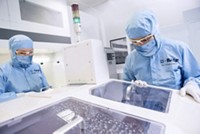Advertisement
Grab your lab coat. Let's get started
Welcome!
Welcome!
Create an account below to get 6 C&EN articles per month, receive newsletters and more - all free.
It seems this is your first time logging in online. Please enter the following information to continue.
As an ACS member you automatically get access to this site. All we need is few more details to create your reading experience.
Not you? Sign in with a different account.
Not you? Sign in with a different account.
ERROR 1
ERROR 1
ERROR 2
ERROR 2
ERROR 2
ERROR 2
ERROR 2
Password and Confirm password must match.
If you have an ACS member number, please enter it here so we can link this account to your membership. (optional)
ERROR 2
ACS values your privacy. By submitting your information, you are gaining access to C&EN and subscribing to our weekly newsletter. We use the information you provide to make your reading experience better, and we will never sell your data to third party members.
Environment
Labs Evolve In China
As China’s economic muscle grows, global chemical companies’ R&D operations in the country evolve.
by A. Maureen Rouhi
January 26, 2015
| A version of this story appeared in
Volume 93, Issue 4

When Western chemical companies began establishing R&D units in China in the mid-1990s, their goal was modest: enable Chinese manufacturers to use their materials. As China’s role in global manufacturing grew, so did the demands on the local R&D of chemical companies.
Within a few years, companies such as Evonik Industries, Henkel, and Solvay had switched to full-scale R&D, the kind that leads to innovation, new products, and better services. Now, their R&D centers in China are tackling bigger challenges, while also generating intellectual property (IP) and confronting other problems along the way.
Solvay’s first labs in Shanghai were set up in 1997 (by Rhodia, which Solvay acquired in 2011) to provide technical support for customers, recalls Pascal Metivier, Solvay’s research and innovation director for Asia. Realizing the need to move beyond technical service, Solvay converted the Shanghai labs to full-scale R&D in 2007, with a budget that today ranks third among Solvay’s global R&D sites. Now, Metivier says, the Shanghai Research & Innovation Center is generating between 20 and 30 patent applications per year, or about 10% of the patents Solvay files worldwide.
For Evonik, an upgrade came in 2013, with the establishment of a Creavis unit in Shanghai. Creavis is Evonik’s centralized innovation arm; it carries out potentially transformational research aimed at sustaining growth and unlocking new business opportunities.
Before then, Evonik’s R&D in China was conducted primarily by its business units and focused on technical service and product development, says Baoshu Chen, Evonik’s head of development for the greater China region. “Evonik is convinced that we need true research for new products in this region,” Chen says. With Creavis China complementing the R&D centers of the firm’s business units—Nutrition & Care, Resource Efficiency, and Performance Materials—“true research is now happening in China.”
At Henkel Adhesives Technology, its Shanghai hub provides technology and innovation for all markets, according to Maria Xenidou, Henkel’s head of adhesives research for the Asia-Pacific region. “We are developing new chemistry and new IP,” Xenidou says. “Up to 80% of the technologies developed here are new patents for us.”
At their China research centers, the three companies have gone well beyond their original reasons for being there. Foremost among their reasons today is customer proximity.
The market in China is “very fast-paced, very dynamic,” Henkel’s Xenidou says.
When customers are breathing down your neck and demanding solutions pronto, decision making must be quick. “If you are in a different time zone, it is inconvenient for the customer,” Chen adds. Customer proximity also dictates the R&D areas best to grow in China.

For Evonik and the other companies, research and product development capabilities are abundant for high-performance polymers sold to the automotive, electronic, and lifestyle and sports industries, because many such products are made or sold in China.
The rapid changes in Chinese society are another reason for true R&D in China. Global trends such as urbanization manifest more quickly in China than in other parts of the world, thereby making the country an early proving ground for products and services that the rest of the world eventually will want.
Another trend where China leads is the rise of the middle class in emerging economies. The growing demand for good-quality and affordable products creates ripe opportunities for innovation in China, according to Xenidou. One example is an adhesive, aimed at the mid-market consumer, that Henkel sells only in China.
“Not everyone can afford the high-performance product marketed under the Loctite brand,” Xenidou says. “With a different cost/performance model, we can make it affordable to the middle class,” whose average income is less than that of the customer who buys the top-of-the-line version. If successful, she says, the adhesive could be extended to other markets with similar consumer profiles.
A third reason for being in China is the rise of automation. Research at Henkel’s Shanghai technology hub yields not only functional materials but also systems that are integrated with a customer’s process to improve production efficiency.
An example is R&D to reduce the amount of stitching in sports shoes. With low-cost labor becoming scarce, manufacturers want to reduce the amount of sewing that takes place in their plants. Henkel responded with rapid-acting polyurethane technologies—developed partly in China—to enable shoemakers to glue a shoe’s top and bottom parts together and an automated system to quickly dispense the adhesive.
Not surprisingly, among the R&D areas cultivated in China are thorny ones for which local need is high, such as sustainability, environmental protection, and balancing burgeoning populations and scarce resources.
To tackle some of these bigger problems, partnerships with universities are common. In Shanghai, for example, Evonik’s Creavis unit focuses on developing next-generation fermentation technologies to support the firm’s long-term goal to replace some chemical syntheses with biological processes and to use renewable raw materials. According to Chen, Chinese academics are leaders in the field, and the unit is conducting joint experiments with several universities to commercialize academic inventions.
In Solvay’s Shanghai center, the thrust of long-term R&D is eco-friendly products and processes to promote sustainability and environmental protection. “China is putting a lot of money in this field,” Metivier says. The questions can be as basic as how to use CO2 as a raw material and as applied as what modifications in Solvay’s manufacturing plants can reduce waste and impurities. For this effort, Solvay has formed a collaboration network that includes two Chinese universities (Fudan and East China Normal), two French universities (Lille University of Science & Technology and École Normale Supérieure de Lyon), and France’s National Center for Scientific Research.
Similarly, Henkel Adhesives Technology has collaborations with Tongji University, in Shanghai, for automotive engineering and with Shanghai Institute of Organic Chemistry for catalysis and synthesis of monomers and polymers.
As they create IP in China, chemical companies are ever more vigilant about IP security. China remains on the “priority watch list” of the Office of the U.S. Trade Representative, which notes “serious concerns about enforcement and protection of trade secrets” in the country.
High-profile disputes underscore the vulnerability of IP rights in China. Two of note in recent years are a clash between U.S.-based SI Group and China’s Sino Legend Chemical over tackifying resins used by the tire industry and Ineos’s accusation that the Chinese chemical giant Sinopec stole its acrylonitrile manufacturing technology.
Evonik’s Chen contends that enforcement of IP rights is improving in China. He points to the establishment of three IP courts and moves to improve judicial transparency. However, Chen adds, “the situation in small cities and remote areas is still behind that in the big cities.”
In a sign of better IP protection for Solvay, in December 2013 the company won an IP lawsuit in a Chinese court against the Chinese firm HySci Specialty Materials. Solvay had sued HySci for infringement of patents for rare-earth mixed oxides used in automobile catalytic converters.
The court victory aside, Solvay’s Metivier says IP protection is still a problem in China. The greatest risk, he explains, is “know-how leakage,” when staff leave the company or succumb to outside offers to divulge trade secrets.
Prosecuting trade-secret theft is made difficult by “lack of discovery to extract key evidence from opponents coupled with high evidentiary standards in China,” says Jeffrey D. Lindsay, head of intellectual property at Asia Pulp & Paper, an Indonesian paper manufacturer with operations in China. Western companies that sue to protect their IP “tend to have success,” Lindsay adds, “although the lower level of damages in China leads some infringers to not fear the law all that much.”
To enhance IP security, “we don’t develop products that can be easily copied,” Xenidou says. “Our materials and processes are quite complicated, sophisticated, and integrated with customer processes. Even if they are published, they are difficult to duplicate.”
Metivier explains that Solvay institutes processes to segregate know-how, so that people do not have all the data on a product or process. “We also follow up with the people leaving the company, identifying where they go and for whom they work,” he says.
Meanwhile, other factors may be dimming China’s innovation sparkle. Metivier notes a growing nationalism that manifests in a belief that the country will succeed on its own. A consequence, he says, is greater difficulty in bringing in foreign scientists, and that worries him. “If you want to be an innovative country, science and development needs to be open,” he says. “China needs to promote exchange to achieve diversity.”
A similar downbeat tone permeates the 2014 business confidence survey of the European Union Chamber of Commerce in China. “A new sober reality is developing,” it says. “An abiding sense of pessimism for future performance is setting in, which is leading many to question whether the good times have ended.”
The dark clouds notwithstanding, China will continue to be a major factor in R&D for global companies. Growth is faster in Asia than anywhere else, Xenidou says. “We want to explore all the possibilities and capture the opportunities in Asia, especially in China. That’s why we are here.”




Join the conversation
Contact the reporter
Submit a Letter to the Editor for publication
Engage with us on Twitter